Šakiai (, Szaki) is a city in the Marijampolė County, Lithuania. It is located 65 km west of Kaunas. It is presumed that Šakiai first expanded from Šakaičai village. By 1719 a church in Šakiai was built. By the 19th century Šakiai already had city rights; it also had a school, Catholic and Lutheran churches, a synagogue, and a post office. During World War II the city was destroyed by the German army.
Šakiai is the birthplace of early Zionist philanthropist Isaac Leib Goldberg in 1860.
Several massacres of Jewish people are alleged to have taken place in Šakiai in World War II, from July to September 1941. The killings are alleged to have committed by an Einsatzgruppen of German SS troops. The involvement of a small number of Lithuanians is also alleged.


















